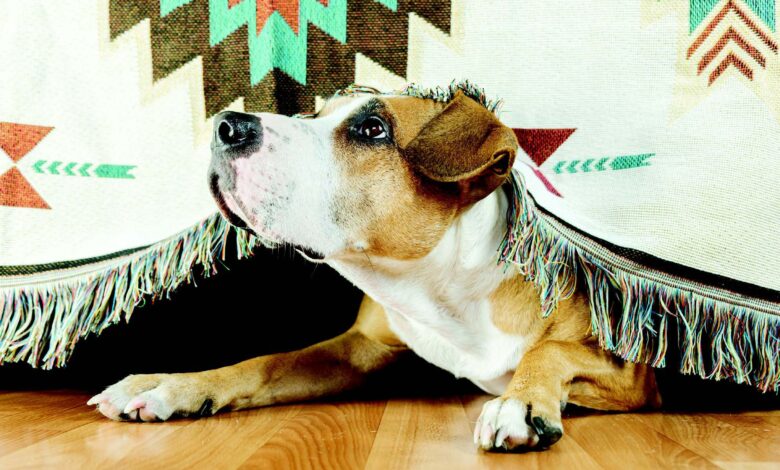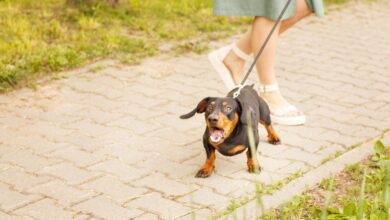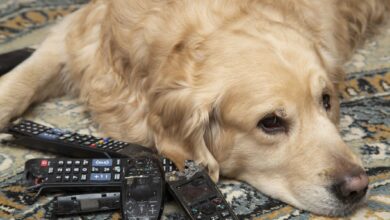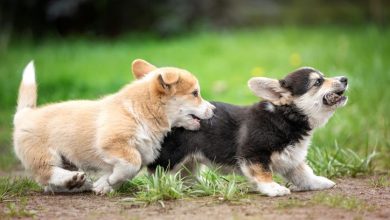Fearful Dog? Teach Avoidance – Dogster

[ad_1]
I see many nervous and fearful dogs in my line of work and even though these emotional states often have a negative impact on a dog’s mental health, fear serves an important function. Unless fear becomes so deeply ingrained that it develops into a phobia, fear is adaptive in that it helps both humans and animals avoid or neutralize danger.
The fear response comes from one of the oldest developed parts of the vertebrate brain: the sympathetic nervous system.
The primary function of this system is to stimulate a physiological reaction in response to a perceived threat. The sympathetic nervous system releases hormones in response to stress, result ing in an adrenaline rush. This activates the ‘fidget, freeze, flight or fight’ response by increasing blood flow to the body’s muscles, elevating blood pressure, increasing heart rate and stopping digestion in order to prepare the body for action. How humans and animals respond to this rush of chemicals will either get them out of a bad situation or deeper into it.
The Value of Choice
One of the best ways to help any dog who is overwhelmed is to:
- Try and understand her perception of a situation
- Safely give her more autonomy and choice over what she wants to approach and what she wants to avoid.
Dogs who are punitively trained have very little control over their lives, but even dogs who are taught in a humane way can be constantly micromanaged by their human caregivers.
Choice is valuable. When dogs have control over where they can move to, who they want to interact with and what they want to avoid, they become more confident.
While the dog lunging at the end of the leash might look badly behaved, think how you would feel if you were tied to someone who made every decision for you and put you into situations that made you fearful. It’s no wonder that leash reactivity is a common behavior issue in dogs, because people don’t realize that being on a leash inhibits a dog’s ability to act naturally.
The Art of Avoidance
Avoidance is one of the most powerful skills to teach your dog. Advocate for your dog by telling your guests to avoid interaction unless your dog makes the decision to interact with them. If your dog doesn’t enjoy guests, make sure that she has access to a safe space like a room or a specific area in a room that is a “no-go” zone for people.
This might seem really simple, but it relieves so much pressure and gives dogs the time to make their own decisions about who they want to greet or avoid. Similarly, if you are on a walk and your dog is uncomfortable being close to other dogs, help relieve the pressure she feels by practicing avoidance and walking off in the other direction.
Understanding what your dog needs in certain situations is made easier if you take the time to observe her reactions in those situations. This is easier if you have someone else handle your dog while you watch her body language and understand what she is trying to communicate.
Let Your Dog Decide
Make a list of what your dog likes and what decisions she makes in different environments:
✤ If your dog finds herself in a situation she doesn’t want to be in and tries to practice avoidance, allow her to leave.
✤ If she chooses to go to her bed when you have guests around, give her the space to settle quietly and allow her some alone time.
Think of all the ways you can give your dog choices like this, which is made easier if you think a few steps ahead and ask yourself how your dog might cope in different situations.
Once your dog understands she has the freedom to take herself away from something if she needs, you’ll see a positive change in her behavior. The dog who has the courage to walk away is much easier to handle than the dog who responds aggressively. Practicing avoidance promotes confidence, and repeated experience helps your dog be happier with the choices she makes.
[ad_2]
Source link






